Engagement Ring - In Progress
Setting
Stone
Purchase any Engagement Ring and receive a $250 Gift Card for your Wedding Band. Ends soon.
Deepen the well of love in the world.
We guarantee that every single purchase directly impacts one person's life by giving them access to clean water.
Salt n pepper diamonds are natural diamonds that get their name from pretty speckles of black and gray throughout their crystals. There are different styles of salt & pepper stones, but the most common are clear or light gray diamonds with a scatter of “pepper” inclusions! Our couples love this look for how unique and natural it feels.
Yes! Salt n peppers are natural diamonds with natural inclusions. In fact, I’m not aware of a lab created version. So, each SnP diamond is crystalized carbon – just like any other diamond. The difference is that peppers show off the plethora of pretty birthmarks they were naturally born with!
No. While there are highly included lab created diamonds, I have yet to see a lab created stone with pretty, evenly spaced pepper. Remember, salt & peppers differ from standard I2 and I3 clarity diamonds is perfect imperfection. If the stone’s inclusions are not attractive, then it’s just not a peppered stone. And, lab stones (which tend to be more regularly patterned instead of organically patterned) just haven’t pulled that off yet.
Yes, but differently than traditional diamonds. S&P stones sparkle a bit differently because of their pepper and because of their faceting. So, while S&P’s are going to give you that crisp, iconic, diamond reflection – they aren’t going to “glitter” the way a traditional white diamond will. This has to do with how a pepper diamond’s inclusions break up the refraction of light, as well as their difference in faceting pattern. Most peppered diamonds are rose cut, as compared with traditional shapes with pavilions (bottom points). And, rose cuts offer a more billowy, magical shimmer than a true sparkle. So, overall, pepper diamonds offer a more organic, ethereal beauty than a traditional “sparkle.”
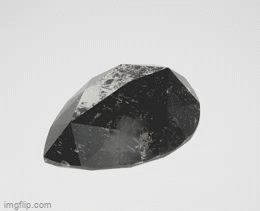
No, GIA does not certify salt and pepper diamonds. This is for two reasons: lack of imitation and clarity. First, because there are no meaningful imitations or lab created peppers, certification is unnecessary to distinguish natural from synthetic. Second, the GIA clarity grading scale is intended to distinguish diamonds based on lack of inclusions. So, because S&P diamonds are determined by their plethora of inclusions, certification would be unhelpful.
No, they are a different class of diamond than “white, eye clean” diamonds are. So, a pepper diamond is not merely an I3 or lower (in other words, poor) clarity stone. A salt & pepper is a stone with artistically located inclusions that make it attractive. Think of S&P inclusions like spots on a dalmatian or patches on a painted horse! Conversely, low quality I3 or “commercial” diamonds are highly included, and unattractive.
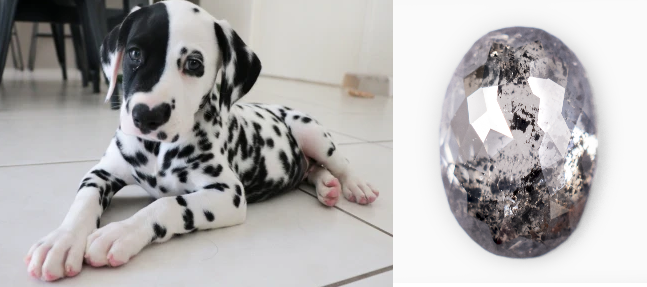
Dalmatian Salt n Pepper Diamond
The top three things to look for in a great salt n pepper are speckle type, faceting style, and quality of faceting.
There are several different speckle types, or “looks,” associated with s&p diamonds. While some do not distinguish between them, I find each category to be unique, and that each couple wants a specific look. So, I call these different speckle types dalmatian, misty, ash gray, and mossy color. So, make sure that you know the speckle type you want before shopping for a s&p, and don’t order sight unseen. Check out a few examples, here!
Gem geek comment: There are also white salt and pepper diamonds that give off an opalescent appearance. These are great opal alternatives!

Dalmatian, Misty, Ash, Mossy, and Opalescent
Generally no, but make sure there are no “surface reaching” inclusions which cause a durability risk. Most diamond inclusions are contained fully within the stone, thanks to thoughtful diamond cutters. However, lower quality cutting can result in surface reaching inclusions which put a stone at risk of chipping. Unfortunately, this is more common in salt n peppers (or stones being passed off as s&p). So, make sure to ask about surface reaching inclusions! You can also look at the stone’s facet reflections to confirm any major durability risks.
Pro Tip: Do Amore reviews every salt n pepper stone we sell for durability risks, so you don’t need to worry with us!
S&P stones can be traditionally faceted (with a pointed bottom) or they can be “rose cut.” Because the bottom point of a diamond acts to reflect and refract light, and s&ps do not sparkle in a traditional way, the pointed bottom is a style item as compared with a quality point. So, also decide whether you want a traditionally faceted shape, or a rose cut. Also, s&p’s come in all sorts of outlines – so also choose a shape!
Pro tip: Choosing a rose cut makes s&p stones look more artistic and organic.
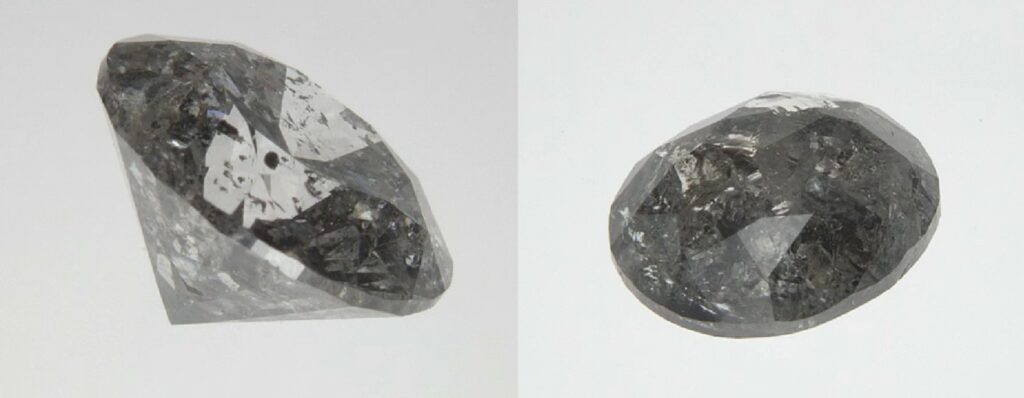
No! Peppered diamonds are significantly less expensive than “white, eye clean” stones. Because SnPs are a non-traditional choice, they do not carry the premium pricing that traditional diamonds do. This means they are a great value!
Salt n pepper diamonds are relatively inexpensive because they are non-traditional, leading to lower demand. And lower demand means better prices! Specifically, the traditional engagement diamond is “eye clean,” in strict opposition to peppers. Peppers would also, generally, fall lower on the GIA grading scale, if one was to attempt to grade them. However, as SnPs are a unique subset of diamonds, we disagree with the practice of grading them on the standard scale.
Salt n pepper diamonds are valued by how attractive their spots are. It is quite similar to how, in a litter of puppies, the tricolor and merle pups will be priced at a premium over pure white or pure black pups.
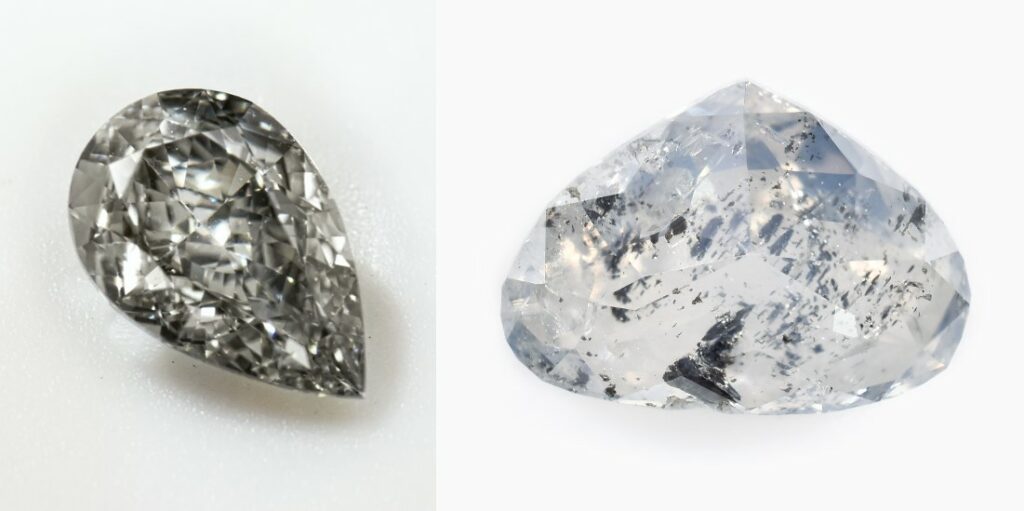
Fancy Gray Diamond vs Salt and Pepper Diamond
Gray diamonds are crystalized carbon (just like “white” diamonds) but in a gray color! They can be natural or lab created. And, they can be salt n pepper or “eye clean.” Gray diamonds look icy and edgy in white metals like platinum or white gold. And, they look warm and organic in warm metal like yellow or rose gold. They are a unique take on a standard engagement ring, while maintaining a classy look. They’re also a great value.
No, however some jewelers use them interchangeably. There are natural and lab created fancy gray colored diamonds that are not “peppered” like salt n pepper stones are. There are also gray colored pepper diamonds! So, it is important to distinguish which you are looking for! Check out the difference in appearance here:
We’d love to answer them for you! Send us an email at care@doamore.com, drop us a note here, or give us a call at 888-492-3456. My name is Corinne, and I’m the gemologist. I’m happy to answer any of your s&p questions!
Verifiably Ethical & Sustainable
Guaranteed 1:1 Impact
Personalized 1:1 Customer Service
handcrafted & american-made
you before us, always
Diamonds, Gemstones, & Metals
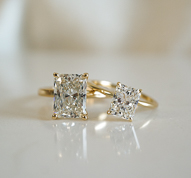
Every piece of Do Amore jewelry begins by not hurting the world. All our natural diamonds are either ethically sourced in Canada, recycled to eliminate additional demand, or accompanied by a blockchain ledger showing every hand your diamond passed through, proving your stone is truly conflict-free.
We also offer sustainable lab-created stones and guarantee all precious metals are recycled to eliminate the environmental impact of mining. Since March 2022, we carry absolutely no Russian diamonds and continue to urge the industry to follow suit.
Clean Water
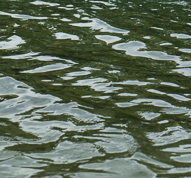
We desire to deepen the well of love in the world. We guarantee that every single purchase—whether engagement ring, wedding band, or piece of jewelry—directly impacts one person’s life by giving them access to clean water.
We do this by directly matching jewelry purchases to people in communities to ensure our funding has a one-to-one impact. We also show you the exact GPS coordinates and a photo of the water well your ring or piece of jewelry helped fund.
Customer Service

As a small, 100% founder- and employee-owned team, one-to-one encounters are at the heart of our values. Whichever way you want support throughout your engagement ring or jewelry purchase process, our team is here to accommodate you.
From high-touch to hands-off, video calls to text messages, you have our dedicated, responsive team on your side from the moment you start your search, to the day your well is built, to the time we meet again.
Engagement Rings, Bands, & Jewelry
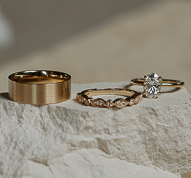
Every Do Amore design, whether one of our own or unique to you, is beautifully handcrafted in America and made specifically for you. Each ring is made to order, every time.
From classic to custom, you have the option to select from dozens of gorgeous settings or work with our design team to create something entirely bespoke. Plus, you are always covered for free inspections, polishing, cleaning, stone tightening, rhodium-plating, and resizing for life.
Our Promise

We care about what matters most to you, not what’s easiest for us. If it’s a minor change to a setting or arriving at a completely custom design, we work to ensure you get precisely what you love.
From statement-making to understated, we have options at any price point. Plus, you always have our team on your side searching to bring you every stone within your specifications. We also offer 30-day returns and a limited lifetime warranty to cover you in the rare event of a manufacturing defect.